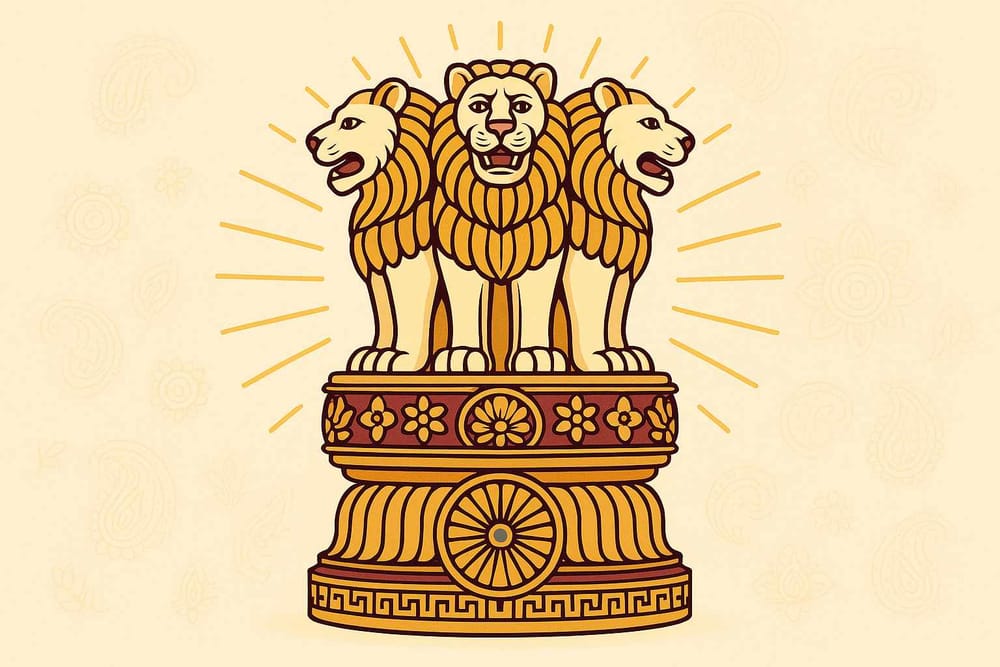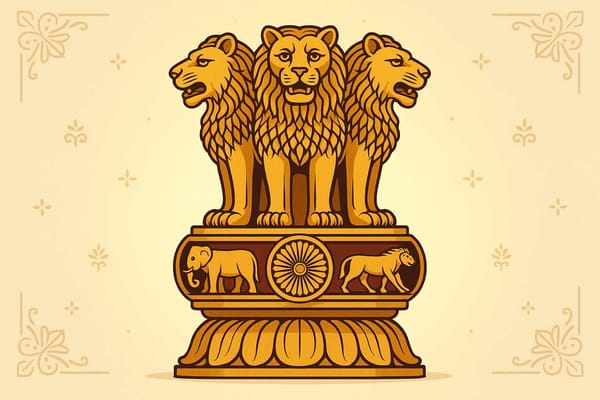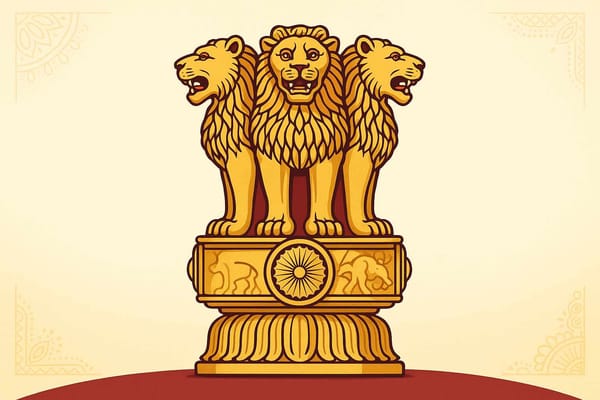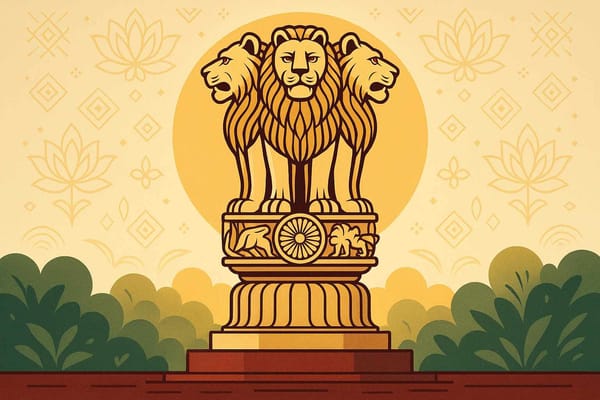
Lion Capital of Ashoka-History and Significance
Every time we hold a coin, glance at a currency note, or open our passport, we see them – four majestic lions, standing back-to-back, roaring silently into the four corners of the world. This symbol is so familiar, so deeply a part of our Indian identity, that we often forget the incredible story it holds. This isn't just a design; it's a piece of our soul, a message carved in stone over two thousand years ago. This is the story of the Lion Capital of Ashoka, a timeless symbol of India's strength, heritage, and enduring values.
A King's Vision: The Historical Roots of the Capital
To understand the Lion Capital, we must travel back in time to the 3rd century BCE, to the era of the great Mauryan Emperor, Ashoka. After the bloody Kalinga war, a transformed Ashoka embraced Buddhism and dedicated his life to spreading the message of Dharma – of righteousness, peace, and non-violence. He wanted to build an empire of ethics, and he chose stone pillars, erected across his vast kingdom, to be his messengers.
He chose Sarnath, near modern-day Varanasi, for one of his most important pillars. This was no ordinary place; it was the sacred ground where Gautam Buddha gave his very first sermon after attaining enlightenment. To mark this holy site, Mauryan artisans, with incredible skill, carved a magnificent capital from a single block of polished sandstone. This masterpiece, lost to time for centuries, was rediscovered during an excavation led by F. O. Oertel in the winter of 1904-05, bringing a vital piece of our history back into the light.
Decoding the Symbols: A Message for Eternity
The Lion Capital is not just a beautiful sculpture; every single element is rich with meaning. It's a lesson in philosophy and governance, designed to inspire generations.
The Four Lions and Their Noble Roar
The most striking feature is, of course, the four Asiatic lions. Standing with regal confidence, they face the four cardinal directions. These lions are not just symbols of royal power or courage; they represent the Buddha, who was known as the 'Lion of the Shakya clan' (Shakyamuni). Their open mouths are not roaring in aggression but are seen as spreading the teachings of Dharma to all corners of the world, a powerful message of peace and universal truth.
The Abacus: A Carousel of Life's Path
Below the lions sits a circular base, or abacus, which is just as significant. It features four animals intricately carved between four wheels (Chakras):
- The Elephant: This is believed to represent Queen Maya's dream of a white elephant entering her womb before Buddha's birth, symbolizing his conception.
- The Bull: The bull is associated with the zodiac sign of Taurus, the month of Buddha's birth, representing his young life as Prince Siddhartha.
- The Horse: This symbolizes Kanthaka, the horse Prince Siddhartha rode when he left his palace in pursuit of enlightenment, marking the Great Departure.
- The Lion: The lion here represents the attainment of enlightenment, the moment Siddhartha became the Buddha, a spiritual conqueror.
The craftsmanship seen here is a testament to the advanced artistic skills of ancient India. This dedication to blending spiritual meaning with architectural beauty is a tradition that has continued for centuries, as seen in marvels like the Jagdish Temple, a masterpiece of Vaishnava traditions.
The Dharma Chakra: The Wheel of Law
The wheel, or the Dharma Chakra, is central to the Capital's message. With its 24 spokes, it represents the noble eightfold path and the cyclical nature of life, death, and rebirth. It is this very wheel that has been placed in the heart of our national flag, a constant reminder of our nation's commitment to moving forward on the path of righteousness and justice.
From an Ancient Relic to Our National Emblem
When India became a republic, our founding fathers sought a symbol that would capture the essence of our ancient civilization and our aspirations for the future. On January 26, 1950, the Lion Capital of Ashoka was officially adopted as the National Emblem of India. It was a perfect choice. It speaks of a legacy not of conquest, but of conscience; not of power, but of principles.
Today, the original capital rests safely in the Sarnath Museum, while its message stands tall on every official document and government building. It reminds us that our nation's foundation is built on courage, compassion, and the timeless pursuit of truth. The legacy of visionary rulers like Ashoka continues to inspire, much like the royal spiritual legacy of Mewar, which shaped its region's cultural heart.
A Living Heritage at Bhaktilipi
At Bhaktilipi, we believe that stories like these are the threads that weave our cultural fabric. We are a digital space dedicated to preserving, reimagining, and sharing India's timeless devotional literature and spiritual heritage. Our mission is to present these sacred texts and powerful stories in a way that resonates with today's generation, while honouring their authenticity.
We bring you curated translations, historical insights, and creative expressions rooted in our traditions. If you felt a connection to the story of the Lion Capital, we invite you to continue your journey of discovery with us. Subscribe to our updates to explore our rich heritage and gain deeper insights into the bhakti traditions that have shaped India.
Stay Connected with Our Community
Discover more articles that delve into the heart of India's spiritual history on our platform. To stay inspired by timeless wisdom delivered right to your inbox or feed, follow us on our social media channels:
- Follow us on Facebook for stories and community updates.
- Join our Instagram family for beautiful visuals and spiritual quotes.
- Subscribe to our YouTube channel for devotional content and narrations.
Conclusion: A Symbol That Continues to Inspire
The Lion Capital of Ashoka is far more than just a historical artifact; it is a living symbol of India's soul. Its message of unity in diversity, moral governance, and interconnectedness is as relevant today as it was over two millennia ago. It stands as a beautiful bridge between our glorious past and a hopeful future, a constant reminder of the strength, integrity, and compassion that define our great nation. Whether admired for its artistic genius or revered for its profound meaning, the Lion Capital will forever remain an emblem of Indian identity and pride.
A passionate group of people dedicated to preserving India's knowledge of Dharma, Karma, and Bhakti for ourselves and the world 🙏.
Comments
Related in

Lion Capital of Ashoka-India's Heritage Explained
Have you ever held a coin in your hand or looked at your passport and truly seen the four lions seated majestically back-to-back? It’s a sight so familiar to us Indians, a part of our daily lives. But this isn't just a design; it's a

The Historical Significance of the Lion Capital of Ashoka: Understand its Enduring Legacy
There are some symbols that are etched into the very soul of a nation. For us in India, the Lion Capital of Ashoka is one such powerful emblem. We see it on our currency notes, on our passports, and on every official government letterhead. But have you ever paused to

The Significance of the Lion Capital of Ashoka: Explores Indian History
Have you ever paused for a moment, holding a currency note or looking at your passport, and truly looked at the four lions standing so majestically? That symbol, the Lion Capital of Ashoka, is something we see almost every day. But how often do we think about its story? It’
